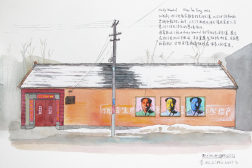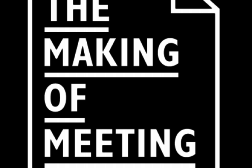Access All Areas, IMMA publication out now!
The Access All Areas symposium at the Irish Museum of Modern Art in 2006 was the second in a series of international symposia that interrogated aspects of museums and contemporary arts practice. This followed Curating Now, in 2004, and preceded Museum21, in 2008. This publication presents texts based on the presentations delivered over the two-day symposium.
Access All Areas addressed a wide range of institutional and personal ideologies governing access to art and artists and the national cultural frameworks that support them. International writers and practitioners were invited to engage in a critical discussion on the issues concerning access in public galleries and museums. This discussion was especially timely in an Irish context as IMMA is a relatively new institution (established in 1991), representing for Ireland the first national cultural institution dedicated to the presentation and collection of modern and contemporary art. Access issues in relation to contemporary art have been on the wider arts agenda for some thirty years and widely applied in community arts and formal education contexts, but policy development for national cultural institutions is at an emergent stage, with the first national policy framework for Education, Community and Outreach (ECO) throughout the national cultural institutions published in 2004.
The symposium’s key note address was given by the art historian and writer, Carol Duncan (USA), best known as one of the pioneers of a new socio-political approach to art history and criticism and one of the strongest feminist voices in new art history. In her paper for this publication, Duncan offers an earlier model for the educational roles of galleries and museums, focusing on the manufacturing city of Newark, New Jersey in the early 19th century, and the work of the social reformer and librarian John Cotton Dana. Dana’s ideology stemmed from the American Library movement, which took force from the 1890s and transformed the public use and perception of the traditional libraries, where book browsing was not allowed and the collection of classical books was reserved for the pleasures of the upper classes. Duncan explains the relevance of Dana’s ideas today, not so much for the specific museum model he advocated as for the questions he asked and for his still powerful critique of museum practices.
Institutional frameworks and the role of contemporary thinking in shaping institutional perspectives on national identity, access, social inclusion, mediation and artists’ pedagogies was the focus for a number of contributors. The invited speakers, representing a cross section of professionals currently responsible for programming in national cultural institutions, set out the context for their work within a national and international framework.
IMMA has developed its access programmes using an open-agenda that employed ‘artist-based’ strategies in engaging many new participants with contemporary art and artists. This model raises the question of support for the development of an emerging professional group of artists, mediators and educators working within this newly defined field, identifying the ongoing challenge of ‘making artworks work’ and how this area of work can be supported in an Irish context into the future.
In contrast, the model at Glasgow’s Gallery of Modern Art (GoMA) in Scotland, presented by the Museum Manager, Victoria Hollows, operates within the context of a national policy that promotes access and a municipal framework that supports ‘social inclusion policies’ such as those enunciated by the UK Labour government. Hollows invites reflection on GoMA’s ‘social justice issues’ based programming, and on how it operates within a determined political agenda. With policy informing programming, such an intervention can be positive when an integrated democratic management structure reflects core values of excellence and equality.
The General Director of MAC de Niterói, Luiz Guilherme Vergara, developed the concept of the visitor as ‘participant’ as being integral to the museum’s programme. His paper outlined a utopian concept for museums that would concern themselves not solely with the collection of objects but also of visitors’ experiences. An ethical and political philosophy informs the structuring of the museum to integrate (as in GoMA) all functions across the institution. His essay addresses the way in which contemporary arts practice influences pedagogical practice and questions how education programmes can become part of a museum’s identity. Continuing with the philosophy of ‘making artworks work’ the pedagogical challenge at Niterói is of connecting visitors to one another and to the wider community.
The Finnish National Gallery is contextualised within the cultural life in Finland by Kaija Kaitavuori, Head of Development, KEHYS, Finnish National Gallery. Looking at how the birth of Kiasma (Finland’s contemporary art museum) fits into the discourse of nation-state and national institutions, she asks if, and in what way, Kiasma represents a continuation or a break in the history of the National Gallery in her country. In keeping with all of the speakers at the symposium, this paper also explores a ‘new paradigm’ for museums and contemporary art. The changing role of artists and viewers places new demands on museums requiring them to change as a consequence. Discussions on relational aesthetics and participatory arts as practiced by contemporary artists led to a possible framework ‘of direct democracy, and presents a new role for museum education’.
The second day of the symposium focused on artists’ practices and art education. The speakers were drawn from a cross section of professionals working in a wide range of organisations, from artists based in non-profit organisations to arts educators in universities, who engage with contemporary art and artists across fields of education from different cultural backgrounds.
In his paper, Dr. Howard Hollands, Principal Lecturer in Art and Design from Middlesex University, presents a lyrical photo essay leading us on a journey that engages with the ‘blackboard’ as a metaphor for learning and oppression, innovation and memory. With examples of artists’ work ranging from Joseph Beuys to films such as Richard Brooks’ Blackboard Jungle and Samira Makhmalbaf’s Blackboards/Takhté he invites the reader to reconsider the potential of connecting the school environment, most specifically the ‘art room’ and formal education concerns, with gallery education and artist pedagogies.
Davide Quadrio, Curator and Director of BizArt, has represented his original presentation in an interview format with Defne Ayas, currently Curator for New York-based PERFORMA. This draws on Quadrio’s experience as a co-founder of BizArt and the multifaceted programme of work he and his colleague Xu Zhen generated for a decade in China, most specifically, in Shangai. He gives an account of the challenges that faced them in a country, which has undergone unprecedented economic growth and change as a result of opening up its borders to the west. He discusses the role of his organisation in supporting artists, in promoting a civil society and in the creation of an engaged position in recent Chinese art.
Methodologies centred on the ‘art of the encounter’ are informed by educational theories on the one hand and artists’ pedagogies on the other. For Janusz Byszewski, Art Educator, Art Therapist and Curator of the Laboratory of Creative Education, Warsaw, the art of encounter is expressed in many ways, ‘adapting itself to the many forms that are presented in contemporary art and like contemporary art, the art of encounter also breaks with routines and habits.’ His essay discusses the role of a workshop leader, the role of the institution and his understanding of a creative situation and his presence in it. He draws on practice both in and outside of the Centre for Contemporary Arts (CCA), in Ujazdowski Castle, Warsaw, Poland.
Dr. Veronica Sekules, Head of Education and Research at the Sainsbury Centre for Visual Arts, University of East Anglia, Norwich, UK, is informed by her academic background as a medievalist to explore a parallel with gallery education similarly occupying the ‘margins’ of gallery or museum practice. In the field of education Dr. Sekules has a particular interest in developing methodologies that explore ways of understanding, which can, in turn, lead to creativity. Her paper addresses the learning that happens at the ‘edges’ of museum programming, drawing on a number of case studies that she has evaluated, including the Tate project, Visual Dialogues (2005-6).
The symposium Chair, Dr. Niamh O’Sullivan, Head of Faculty, Visual Culture, National College of Art and Design, Ireland, identified the overarching theme of the symposium, as an exploration of the ‘transforming potential of museums’ and the importance of access. In this respect it was suggested that ‘if professionals believe in the ’transforming power of museums,’ the profession should be concerned with four key concepts – accessibility, meaningfulness, participation and relevance.’
The negotiation of accessibility and its effectiveness as a transformative force has to be mindful of existing institutional tensions. In the symposium, museum education professionals were described as ‘deconstructing the canon’ mapped by their curatorial colleagues. While creating opportunities to broaden the reach of museums to include a greater diversity of public/s, it was proposed that issues relating to access could never be ‘definitively resolved’. These issues in essence are concerned with the shifts in institutional frameworks, societal changes and pedagogical strategies, and to be effective they need to be constantly addressed, defined, and negotiated. The museum as a public space has to ‘imagine and reimagine our world,’ providing citizens with ‘a space that might challenge us to see ourselves in unfamiliar ways but also to understand ourselves as located both locally and globally in our concerns’ (Duncan, 2006).
The factors that shape practice are informed by the policies of the individual institution or, in a wider sphere, government policies regarding democratic rights of access and participation. Developments in contemporary arts that have influenced a renewed interest in artists’ practices of ‘collectivity, collaboration and direct engagement’ with specific constituencies particularly questions the ‘role’ of the educator. A range of practices taking into account progressive educational theories, critical pedagogy and artists’ pedagogy informs the personal motivation of professionals. Personal and political agendas combine to challenge the hegemony of our institutions and to animate democratic access to culture and to activate full participation in society.
A number of common themes emerged: a viewpoint expressed was that of the Blackboard Jungle as an analogy for abandoning ‘professional expertise or intellectualism’ in favour of a more democratic pedagogical framework. This was countered by advocacy for the pedagogy of Constructivism and Co-Constructivism. Pringle’s research as part of the En-quire programme was cited as a learning scaffold worthy of consideration. This scaffolding of learning accommodates collaborative learning and facilitates access to a ‘reservoir of ‘tacit’ knowledge’ in learners (Sekules, 2006). Further discussion ensued on developing policies at an institutional level of making ‘artworks work’ and the inherent value of this approach as opposed to a more passive or ‘neutral facilitation’. Museums were recognised as not being neutral spaces and it was agreed that the politics and ethics of the museum space have to include the diversity of the views of audiences.
This volume of essays expands on the presentations and discussions from Access All Areas. In addition to the original speakers IMMA has invited Anna Colford, writer and educator, to re-locate these papers in the current global economic climate, restating the importance of maintaining the significant development with regard to public access that has emerged internationally in the last three decades to cultural institutions.
IMMA would like to thank and acknowledge the following: Niamh O’Sullivan for her intelligent and thoughtful chairing of the Access All Areas symposium; all of the contributors to the publication and participants in the two-day event; all of the artists on the IMMA Artists’ Residency Programme; artist Jesse Jones and the Fire Station Artists’ Studios; and the event sponsors, including the Finnish and Polish Embassies.
I would also like to thank the Director, Enrique Juncosa, the Board and all of my colleagues across the museum in particular those in the Education & Community Department, Assistant Curators Janice Hough and Mark Maguire who were moderators at the event, and Curator Caroline Orr who worked on the publication, alongside Imelda Barnard, Copy-Editor. I would like to especially note the input that Sophie Byrne, Assistant Curator, had in the realisation of the symposium and her role as Assistant Editor of this publication.
Helen O’Donoghue, Senior Curator: Head of Education & Community programmes



